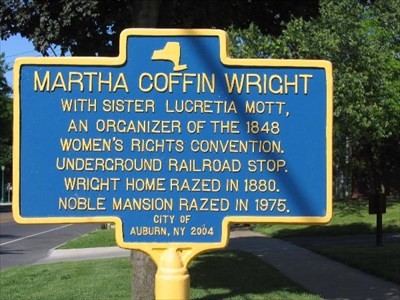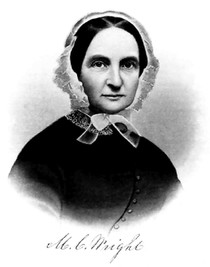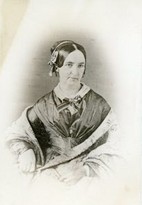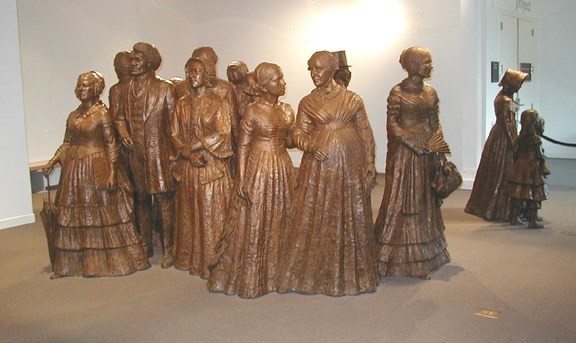Martha Coffin Wright House
Introduction
Text-to-speech Audio
The home of Martha and David Wright stood here until it was razed in 1880. Martha Coffin Pelham Wright was an abolitionist and suffragette who was a leader in both movements. The Wright home was a stop on the Underground Railroad and Martha Wright presided over anti-slavery meetings through the Civil War. Martha C. Wright, along with her sister Lucretia Mott, helped organize the First Women's Right Convention in Seneca Falls, organized national conventions after that, and served as the president of the National Woman Suffrage Association.
Images
Martha Coffin Wright Historical Marker

Martha C. Wright, c. 1855

Martha Coffin Wright

A pregnant Martha Wright depicted in the "First Wave Statue" at Women's Rights National Historical Park.

Backstory and Context
Text-to-speech Audio
Martha Coffin was born into a Quaker family on December 25, 1806. She was the youngest of eight and Lucretia Coffin Mott was her older sister. Martha Coffin was born in Boston, Massachusetts, but her family moved to Philadelphia early in her life. Coffin attended school in Philadelphia and attended a Quaker boarding school. After her father’s death in 1815 her mother, Anna Folger Coffin, opened a boarding house in Philadelphia. This is where Martha Coffin met her first husband. In 1822, Peter Pelham boarded with the Coffins. He was a veteran of the War of 1812 and was in Philadelphia for medical care. Martha and Peter fell in love, but Mrs. Coffin refused to consent to the marriage because Peter was not a Quaker. After a few years, Martha’s mother did consent to their relationship, but Martha was expelled from the Quaker community for marrying a non-Quaker. Martha and Peter Pelham had one child, Marianna. Sadly, Peter Pelham died only about two years into their marriage and Martha moved to live again with her mother, who at this point had moved to Aurora, New York. She worked for a few years at a Quaker girls’ school until 1829 when she met and married David Wright. Wright was a Quaker and was building a law practice, and the family moved to Auburn, NY to be close to the county seat for his work. In addition to Mariana, Martha had six children with Wright (three of which died).
Martha Wright was an ardent abolitionist and was involved in the women’s rights movement. She attended the founding of the American Anti-Slavery Society in 1833 and attended and presided over many anti-slavery conventions. The Wright home in Auburn, NY was a station on the Underground Railroad and Martha worked with Harriet Tubman to house slaves in her kitchen. Like many women, the abolitionist movement brought Martha C. Wright into the women’s rights movement. In 1840, her sister Lucretia Mott met Elizabeth Cady Stanton at the World Anti-Slavery Convention in London where the female delegates were turned away and not allowed to participate. Mott and Stanton agreed that they needed to organize an event to consider the inequalities in women’s rights. In the summer of 1848 Lucretia and James Mott stayed with Martha Wright and Martha participated in the meeting with her sister, Elizabeth Stanton, Jane Hunt, and Mary Ann M’Clintock to plan the First Women’s Rights Convention. A visibly pregnant Martha Wright attended the Seneca Falls convention in July 1848 and Lucretia Mott read one of her articles on the first day of the meeting. In addition to continuing her abolitionist work, Wright served in the leadership organizing national women’s conventions through the 1850s and 1860s. After the Civil War Martha Wright worked with the National Woman Suffrage Association and served as the organization’s president in 1874.
Martha Coffin Pelham Wright died on January 4, 1875 and is buried in Fort Hill Cemetery. The Wright home in Auburn, NY was razed in 1880.
Cite This Entry
Thompson, Kathleen. "Martha Coffin Wright House." Clio: Your Guide to History. July 6, 2021. Accessed March 20, 2025. https://theclio.com/tour/1962/13
Sources
“A Very Dangerous Woman: Martha Wright and Women’s Rights.” UMass Press. Accessed July 6, 2021. https://web.archive.org/web/20050308071744/http://www.umass.edu/umpress/spr_04/penney.html.
Boland, Sue. “Biography of Martha C. Wright, 1806-1875.” Biographical Database of NAWSA Suffragists, 1890-1920. Alexander Street. Accessed July 6, 2021. https://documents.alexanderstreet.com/d/1010113814.
“House Honors Martha Coffin Wright.” Women’s Congressional Policy Institute. Accessed July 6, 2021. https://www.wcpinst.org/source/house-honors-martha-coffin-wright/.
“Lucretia Mott.” Women’s Rights National Historical Park. National Park Service. April 6, 2020. Accessed July 6, 2021. https://www.nps.gov/wori/learn/historyculture/lucretia-mott.htm.
“Martha C. Wright.” Women’s Rights National Historical Park. National Park Service. February 26, 2015. Accessed July 6, 2021. https://www.nps.gov/wori/learn/historyculture/martha-c-wright.htm.
“Martha Coffin Pelham Wright.” National Women’s Hall of Fame. Accessed July 6, 2021. https://www.womenofthehall.org/inductee/martha-coffin-pelham-wright/.
“Martha Coffin Wright, Auburn, NY.” Waymarking.com. Accessed July 6, 2021. https://www.waymarking.com/waymarks/wm1ZDZ_Martha_Coffin_Wright_Auburn_NY.
“Report of the Woman’s Rights Convention.” Women’s Rights National Historical Park. National Park Service. February 26, 2015. Accessed July 6, 2021. https://www.nps.gov/wori/learn/historyculture/report-of-the-womans-rights-convention.htm.
“Martha Coffin Wright, Auburn, NY.” Waymarking.com. Accessed July 6, 2021. https://www.waymarking.com/waymarks/wm1ZDZ_Martha_Coffin_Wright_Auburn_NY.
"Martha Coffin Wright." Wikipedia. Accessed July 6, 2021. https://en.wikipedia.org/wiki/Martha_Coffin_Wright.
“Martha Coffin Pelham Wright.” National Women’s Hall of Fame. Accessed July 6, 2021. https://www.womenofthehall.org/inductee/martha-coffin-pelham-wright/.
"The First Wave Statue Exhibit." Women's Rights National Historical Park. National Park Service. February 26, 2015. Accessed July 6, 2021. https://www.nps.gov/wori/learn/historyculture/first-wave-statue-exhibit.htm.

